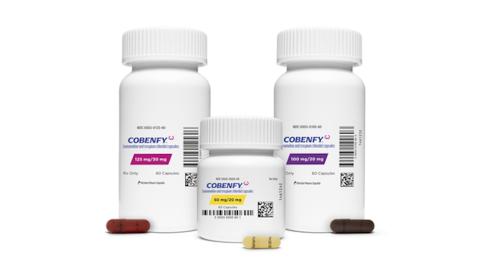
BMS ends decades-long drought in novel schizophrenia drugs
Newsletters and Deep Dive digital magazine





From the early anatomical studies of the Monro dynasty in the 18th century to the groundbreaking application of AI in drug discovery in the 21st, Scottish innovators have consistently been at the forefront of medical progress.
As we trace this journey through the centuries, discover how this legacy of innovation continues to inspire and inform current medical research in Scotland and beyond.
The 18th century marks the emergence of the Monro dynasty, a family whose contributions to anatomical science cemented Scotland’s reputation as a global leader in medical education. Alexander Monro, appointed the first Professor of Anatomy at the University of Edinburgh, laid the cornerstone of a legacy that would last for three generations.
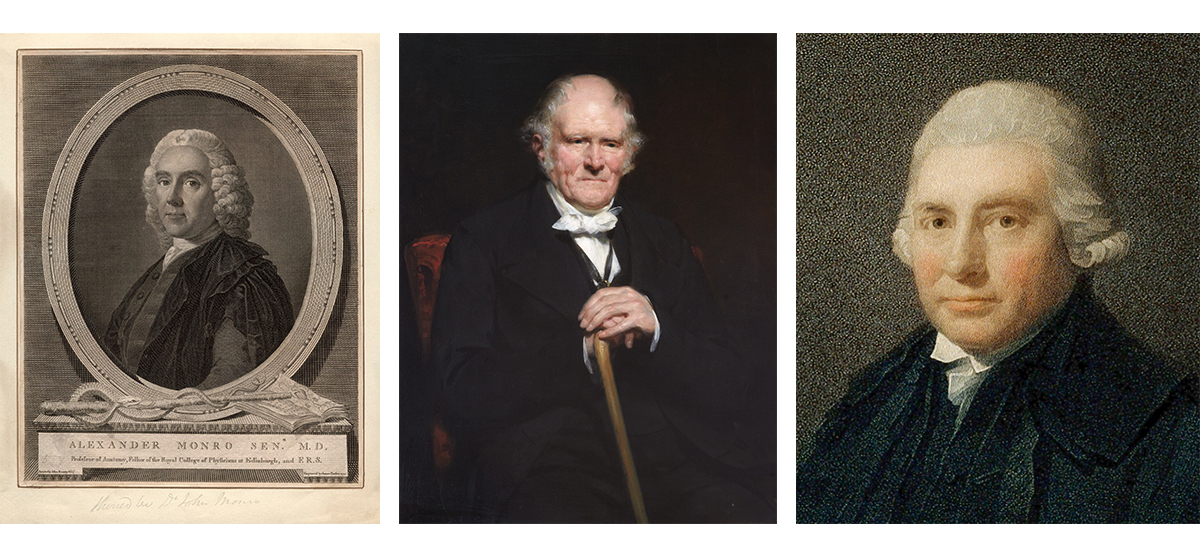
Images left to right:
(Left) Alexander Monro Primus by Allan Ramsay. Credit: Public domain, via Wikimedia Commons
(Middle) Alexander Monro Secundus by James Heath (1757–1834), after Henry Raeburn (1756–1823). Credit: Public domain, via Wikimedia Commons
(Right) Alexander Monro Tertius by John Watson Gordon. Credit: Public domain, via Wikimedia Commons
His lectures at the old Surgeons' Hall drew large crowds, sparking widespread interest in anatomical studies, but also controversy due to the increased demand for cadavers. Despite his public condemnation of body-snatching, Monro’s position highlighted the tension between medical progress and societal norms of the time – a challenge that would be revisited two generations later during the notorious activities of William Burke and William Hare in 1828. His son, Alexander Monro secundus, and his grandson, Alexander Monro tertius, succeeded him in the Chair of Anatomy, continuing this anatomical dynasty for a staggering 126 years. Together, their work advanced the understanding of human anatomy, establishing Edinburgh as a preeminent centre for medical education.
In 1753, James Lind published his seminal work demonstrating the link between citrus fruits and the prevention of scurvy, which became one of the earliest examples of a controlled clinical trial. Although citrus was not a traditional pharmaceutical, Lind’s discovery had a profound impact on naval medicine, illustrating the therapeutic potential of dietary interventions. Not long after, William Cullen, another prominent Scottish physician, published First Lines of the Practice of Physic in 1777. This textbook systematised contemporary medical knowledge and became a standard reference across Europe and North America, further enhancing Scotland’s influence on global medical education for generations to come.
The close of the 18th century saw yet another pioneering figure emerge in John Hunter, whose posthumous work, A Treatise on the Blood, Inflammation, and Gun-Shot Wounds, published in 1794, laid the groundwork for modern surgical practices. Hunter’s insights into inflammation and wound healing were foundational to the development of scientific surgery, pushing the boundaries of what was then possible in treating trauma and vascular conditions.
The 19th century was a period of immense innovation for medicine in Scotland, marked by breakthroughs in anaesthetics, antiseptics, and surgical techniques. In 1847, Sir James Young Simpson introduced chloroform as an aesthetic during childbirth and surgery, revolutionising the field by significantly reducing pain and suffering.
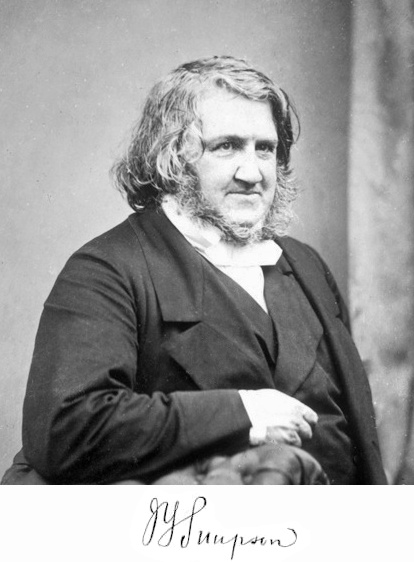
Image: Sir James Young Simpson and Chloroform (1811-1870). Credit: Public domain, via Wikimedia Commons
Simpson’s discovery came about through a series of informal experiments with colleagues at a dinner party, where they inhaled various substances, ultimately recognising chloroform’s potential. His announcement of chloroform as a new anaesthetic sparked immediate demand, as well as moral outrage, until ultimately gaining the seal of respectability when Dr John Snow used the agent to aid Queen Victoria in the delivery of her eighth child.
Just six years later, in 1853, Scottish physician Alexander Wood invented the hypodermic syringe, a tool that would become indispensable in modern medicine. Inspired by the mechanism of a bee’s sting, Wood’s syringe allowed for precise administration of drugs directly into the bloodstream, paving the way from smaller, measured doses. However, the risk of infection remained a prominent obstacle for doctors and it would be many years until the importance of sterilisation would be understood.

Image: Residents at the Old Royal Infirmary, Edinburgh, summer 1854: left to right, John Beddoe (seated left), John Kirk (back row), Joseph Lister (seated in front row), Pringle (back row), David Christison (seated), Patrick Heron Watson (back row), Alexander Struthers (seated right). Credit: Wellcome Collection via Wikimedia Commons
In 1867, Lord Joseph Lister, another towering figure in Scottish medical history, published On the Antiseptic Principle in the Practice of Surgery, in which he introduced the use of carbolic acid (phenol) as an antiseptic. This breakthrough significantly reduced the incidence of post-operative infections, marking a turning point in surgical outcomes. Lister’s work, based on the germ theory of disease, set the stage for modern antiseptic and sterilisation practices, dramatically improving survival rates in surgeries.
By the end of the century, Sir Patrick Manson’s work on tropical diseases brought further acclaim to Scottish medicine. In 1896, Manson proposed the mosquito-malaria theory, which was crucial in understanding the transmission of malaria, a major global health issue at the time. His insights eventually led to the development of anti-malarial drugs, solidifying Scotland's role in advancing tropical medicine.
The 20th century heralded the dawn of the antibiotic era, thanks to the work of Alexander Fleming. In 1928, upon returning from a holiday, Fleming noticed something unusual in one of the petri dishes he had been using to study the boil-causing bacteria Staphylococcus. He observed a strange clear substance encircling a small moldy growth that had developed in the dish.
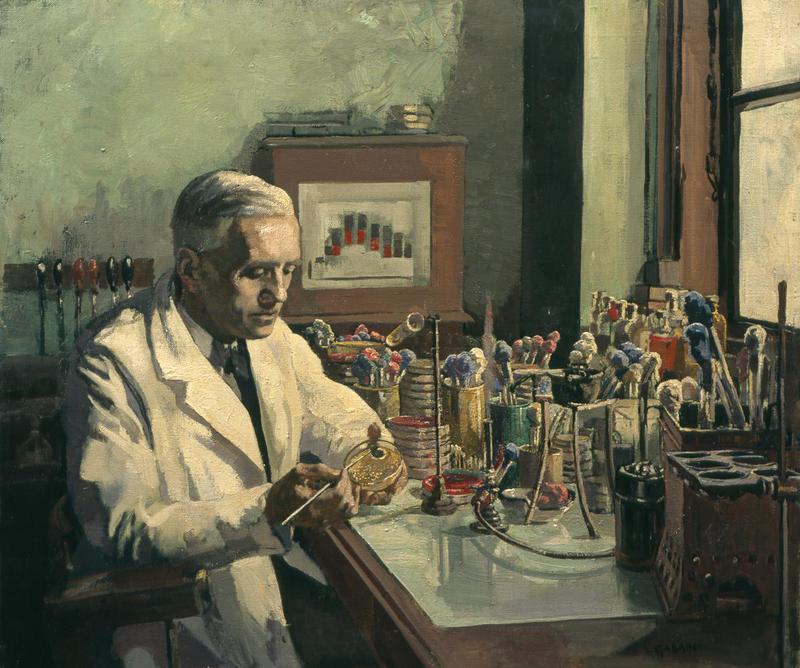
Image: Sir Alexander Fleming,, the discoverer of Penicillin by Ethel Leontine Gabain. Credit: Public domain, via Wikimedia Commons
Now, for most people, the appearance of mold is rarely a cause for celebration – but for the Scottish bacteriologist mysterious secretions from one blob of mold proved to be the catalyst for a breakthrough in life-saving medication. Fleming found that his "mold juice" was capable of killing a wide range of bacteria, such as streptococcus, meningococcus, and the diphtheria bacillus. He renamed his serendipitous discovery penicillin.
While it may have been a lucky development, this breakthrough marked the beginning of modern antibiotics, transforming the treatment of bacterial infections and saving countless lives. Penicillin became the first mass-produced antibiotic and remains a cornerstone of medical treatment to this day.
Scotland’s contributions to medical innovation continued with Alick Isaacs’s discovery of interferon in 1957, a protein that plays a critical role in the body’s defence against infections. Shortly after, Sir David Jack developed salbutamol in the 1960s, an anti-asthma treatment that significantly progressed respiratory care.
Little more than a decade later, in 1978, Professor Ken Murray’s identification of the hepatitis B virus led to the creation of the first recombinant vaccine, further illustrating Scotland’s enduring impact on global health.
The 20th century closed with a series of additional breakthroughs, including Sir James Black’s development of beta-blockers, for which he was awarded the Nobel Prize in 1988. Beta-blockers transformed the treatment of cardiovascular disease, highlighting the critical role of Scottish innovation in pharmaceutical development.
As the world approached a new millennium, excitement mounted around the possibilities of a new, technology-enabled era of medicine. But the buzz surrounding this once-in-a-lifetime event could only be matched with an unexpected, and highly controversial, breakthrough – oh, and a sheep.

Image: Dolly as a lamb with her adoptive mother. Photo courtesy of the Roslin Institute, University of Edinburgh
Dolly the sheep made international headlines in 1996, when a team of researchers led by Ian Wilmut at the Roslin Institute near Edinburgh announced that they had brought science fiction to life by successfully cloning Dolly the sheep. Dolly became the first mammal to be cloned from an adult somatic cell, a process that involved transferring the nucleus from an adult sheep's mammary gland cell into an enucleated egg cell.
This milestone demonstrated that specialised adult cells could be reprogrammed to create an entire organism, challenging long-held assumptions about cellular differentiation. The achievement opened new possibilities in genetics, biotechnology, and regenerative medicine, sparking both scientific excitement and ethical debates on the future of cloning technology.
Entering the 21st century on a high after achieving the seemingly impossible, the pressure was on for researchers to continue Scotland’s legacy as a leader in medical innovation. But, with groundbreaking contributions spanning across stem cell research, prosthetics development, and regenerative medicine, it seems that the nation’s scientists have taken the challenge in their stride.

In a significant development for biomedical engineering, 2008 marked a milestone in prosthetics with the creation of the iLimb by Touch Bionics, the world's first commercially available multi-articulating prosthetic hand. This innovation significantly enhanced the quality of life for amputees worldwide.
In 2013, researchers from Edinburgh's Heriot-Watt University unveiled a pioneering 3D printing technique for stem cell clusters, potentially accelerating the creation of artificial organs. This innovative approach, utilising an adjustable "microvalve" to layer human embryonic stem cells, not only offers hope for future transplant-ready organs, but also provides more accurate tissue models for drug testing, reducing the need for animal trials.
The following year saw two significant breakthroughs. The University of Strathclyde developed a rapid diagnostic test for bacterial meningitis using Surface Enhanced Raman Scattering (SERS), enabling life-saving diagnoses within minutes. Concurrently, researchers at the University of Edinburgh made substantial progress in creating human liver tissue from stem cells, opening new avenues for drug testing and organ transplantation technologies.
Scottish scientists also played a crucial role in combatting the COVID-19 pandemic, contributing to vaccine development and vital research on the SARS-CoV-2 virus. In 2021, Dundee-based researchers made significant strides in understanding Parkinson's disease, identifying key mechanisms in the PINK1 gene that could lead to new treatments.
Most recently, in 2024, the University of Dundee further advanced Parkinson's research by uncovering the inner workings of a molecular switch that protects the brain against the disease's development. This breakthrough reveals unique elements of the PINK1 switch, offering new targets for therapeutic interventions.
From the anatomical studies of the Monro dynasty in the 18th century to the modern applications of AI and stem cell research, Scotland has been a beacon of medical innovation. Each century has brought new discoveries, each decade advancing the boundaries of what is possible in healthcare. Today, as Scottish researchers tackle the challenges of antibiotic resistance, cancer treatment, and neurodegenerative diseases, the nation’s legacy of medical excellence continues to inspire and shape the future of global medicine.

Eloise McLennan is the editor for pharmaphorum’s Deep Dive magazine. She has been a journalist and editor in the healthcare field for more than five years and has worked at several leading publications in the UK.
Supercharge your pharma insights: Sign up to pharmaphorum's newsletter for daily updates, weekly roundups, and in-depth analysis across all industry sectors.

In the cautious world of healthcare, "going viral" typically raises alarm bells. Yet, for a select few medications, virality can catapult them from mere blockbusters to cultural phenomena. Joining the ranks of Viagra, Xanax, and Botox, a new superstar has emerged: Ozempic.
Ozempic, along with its sister drug Wegovy, belongs to a new class of therapeutic known as GLP-1 receptor agonists. Originally developed for diabetes management, these medications have found a second life as potent weight loss aids. They work by mimicking the action of a hormone called glucagon-like peptide 1 (hence GLP-1), stimulating the body to produce more insulin and decreasing blood sugar spikes by slowing digestion.
With 890 million people affected globally and 42% of American adults classified as obese, the allure of a "miracle" weight loss solution – an average 15% weight reduction, according to clinical research – that reduces your food intake, appetite, and hunger is undeniable.
However, when the realms of beauty and pharma collide, the results can be explosive – and not always in a good way. Ozempic has transcended its medical roots, finding its way into rap lyrics, daytime TV, and even Jimmy Kimmel's Oscars monologue.

This meteoric rise from humble diabetes drug to cultural phenomenon has sent shockwaves through the pharmaceutical supply chain. Despite first gaining FDA approval in 2017, in under three years prescriptions surged 300%, reaching 9 million by September 2023, leaving manufacturers struggling to meet demand.
Indeed, beneath the glitz of Hollywood transformations and viral TikTok challenges lies a darker reality. The “trendification” of Ozempic and semaglutide is putting immense pressure on supply chains and creating a dangerous vacuum – one that's increasingly filled by counterfeit medications, placing countless patients at risk.
Despite its reputation as the “Hollywood weight loss drug”, it’s crucial to note that Ozempic has never been approved for weight management. Only three drugs – Novo Nordisk’s Wegovy and Saxenda, and Eli Lilly’s Zepbound – are actually approved for that purpose. Now, if used correctly, these drugs can be a lifeline for patients. Typically, a responsible doctor approaches prescriptions with a titration mindset: starting at a low dose and slowly increasing it to find the optimal level for each individual patient.
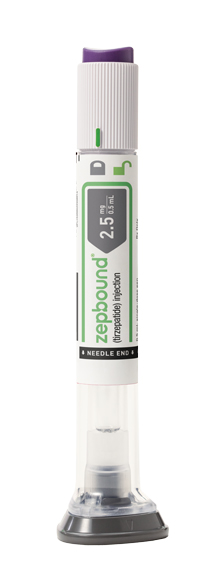 However, social media paints a very different picture of GLP-1 usage. TikTok, in particular, is flooded with posts promoting rapid, extreme weight loss – sometimes as much as 10 to 15 pounds in a week – by people who do not appear to have a medical need for a weight loss drug. These posts dramatically outnumber those posted by patients using the platform to spread awareness and share experiences, and typically omit critical information about responsible use and potential side effects.
However, social media paints a very different picture of GLP-1 usage. TikTok, in particular, is flooded with posts promoting rapid, extreme weight loss – sometimes as much as 10 to 15 pounds in a week – by people who do not appear to have a medical need for a weight loss drug. These posts dramatically outnumber those posted by patients using the platform to spread awareness and share experiences, and typically omit critical information about responsible use and potential side effects.
Even under prescription guidelines, drugs like Ozempic come with side effects that are extensively studied and regulated. When used without medical supervision, the risks become unpredictable and potentially dangerous. Influencers have amplified this trend, with TikTok becoming the breeding ground for the “Ozempic phenomenon”. Hashtags like #Ozempic and #OzempicJourney have proliferated, transforming the drug into a perceived “quick-fix” for rapid weight loss, divorced from its original medical context.
“It was not expected to happen,” says Tinglong Dai, a public health supply chain expert from Johns Hopkins Carey Business School. “Ozempic serves a relatively niche market for type 2 diabetes patients, but that’s not the reason it’s in shortage now. The surge in demand stems from people discovering its off-label use, turning it into a trend, almost like a fashion statement. Social media accelerated this demand overnight.”
TikTok has indeed turned Ozempic into a lifestyle trend, with over 273 million views on the #Ozempic hashtag alone. Videos range from testimonials of rapid weight loss to viral parodies, like the “Ozempic face” trend, where users joke about the gaunt appearance the drug allegedly gives them. Parodies of the Ozempic jingle and challenges like the “Ozempic hand” test further underscore how the drug has infiltrated popular culture. Once a serious treatment for metabolic conditions, it is now casually discussed alongside fashion and beauty trends.
But this popularity comes with serious risks. The informal and often misleading discourse on platforms like TikTok lacks the critical medical oversight that typically accompanies prescription medications. Social media influencers, often unregulated, showcase examples of rapid weight loss, sometimes using images of individuals who wouldn’t even be classified as obese. As more users seek out Ozempic for weight loss, it has caused widespread shortages, leaving diabetes patients – who rely on the drug for their health – struggling to access it.
Despite the drug’s viral fame, actually obtaining Ozempic is no easy task. The process is not as simple as seeing a TikTok post and getting a prescription; it involves a comprehensive evaluation of the patient’s health and lifestyle. Patients often face significant barriers, with insurance companies employing prior authorisation processes to manage costs and ensure proper use. This can require consultations with obesity specialists or participation in lengthy weight management programmes before a GLP-1 receptor agonist is even considered. Many are discouraged by the high price tag, even with insurance coverage, and some struggle to afford the copays.
Persistent drug shortages add to the complexity, leaving patients unable to fill their prescriptions, even after navigating the insurance maze. These barriers have created a complex landscape wherein demand outstrips supply, fuelling frustration for legitimate patients and encouraging the rise of a dangerous black market for counterfeit drugs.
The core issue isn’t just production; it’s the sheer volume of demand. With approximately 40% of the US population struggling with obesity, the pool of potential GLP-1 users has ballooned far beyond type 2 diabetes patients. “You no longer talk about 5% or 6% of the population; you’re talking about 40%,” says Dai. This unexpected growth has left many diabetes patients in a precarious position, struggling to fill prescriptions, often travelling hundreds of miles in search of the drug.
Pharmaceutical companies are now racing to catch up. Eli Lilly has invested $5.3 billion to expand manufacturing capacity, while Novo Nordisk is building a $4.1 billion fill-finish plant in Clayton, North Carolina. However, these expansions take time, with Dai noting, “It can easily take two to three years to complete the validation process, get all the paperwork, and get your plants inspected. You won’t be able to start production as early as 2026.”
The complexities of biomanufacturing are a significant hurdle. Precise control over temperature, contamination prevention, and compliance with regulatory standards make scaling up production a lengthy process. “You need a lot of workers, testing, retesting, and maintaining conditions to ensure safety. It’s a very tricky process,” Dai emphasises.
As pharmaceutical companies work to scale up production, they must also manage patient expectations. Healthcare providers have been advised to limit new prescriptions, and off-label use has been discouraged. “The best thing they can do is lower everyone’s expectations, while they spend billions of dollars to increase production,” says Dai.
With significant investments underway and new entrants like Sanofi and AstraZeneca considering the market, there is optimism that supply will eventually meet demand. However - as Dai cautions - “everything that goes up must eventually come down”, hinting that the current frenzy around GLP-1s may subside, leaving manufacturers to strike a careful balance between production and demand.
Tim Mackey, a professor at UC San Diego who has conducted research into no-prescription GLP-1 purchases online, notes: "Whenever a drug becomes popular, it's going to be available illegally online." Indeed, Mackey’s research uncovered over 1,000 links related to illegal sales of semaglutide, with 42% belonging to 59 illegal online pharmacy sites. These sites often masquerade as research chemical vendors or tout the drugs as "pharmaceutical grade" or "not for human consumption", without requiring a prescription. According to Mackey, "Even though they're representing themselves as research chemical providers, they're actually very directly selling into the human patient market."
The issue has caught the attention of global regulators, who have issued warnings about counterfeit semaglutides. In the UK, the Medicines and Healthcare products Regulatory Agency (MHRA) reported seizing 369 potentially fake Ozempic pens between January and October in 2023, marking the first identification of such counterfeits in the country. The United States FDA has seized thousands of counterfeit Ozempic units and, in June 2024, the World Health Organization (WHO) issued a medical product alert regarding falsified batches of semaglutide products, specifically Ozempic, detected in Brazil, the UK, and the US.
The counterfeit operation extends beyond mere imitation. Criminals are using forged drug batch numbers to sell dangerous lookalike weight loss products, potentially linked to a massive global counterfeiting operation. Pharmaceutical companies authenticate batches of drugs with combinations of letters and numbers printed on the packaging, which are then used to track the product in a given country. However, criminals can obtain these batch numbers through corrupt connections at manufacturing facilities or by purchasing genuine drugs and using scanning technology to copy the packaging.
The health risks posed by counterfeit drugs are severe. Regulatory bodies worldwide have reported incidents of severe side effects linked to fake semaglutide products, including hypoglycaemia and seizures. In Austria, patients experienced life-threatening symptoms after using falsified Ozempic, while in Lebanon 11 people suffered dangerously low blood sugar after injecting suspected counterfeit versions.
The problem extends beyond just drug quality. Mackey's team found that many illegal sellers engage in non-delivery schemes or scams, including hidden charges, such as fake customs fees. In one instance, they were asked for an additional $1,000 to clear supposed customs fees, which was later confirmed to be a scam.
As the demand for GLP-1 drugs continues to rise and access remains limited, the proliferation of counterfeit products is likely to persist. As Mackey warns: "It's just the beginning of a long process where we're going to have counterfeit GLP-1s on the web, and it's not going to be something we solve very quickly."
As TikTok tightens its guidelines and pharmaceutical companies race to address supply issues, a larger question looms: are manufacturers truly prepared to navigate the combined forces of social media-driven demand and regulatory loopholes in the pharmaceutical market?
The ongoing battle against counterfeit GLP-1 drugs and supply shortages highlights the complex challenges faced by companies like Novo Nordisk and Eli Lilly. Despite proactive measures, including legal actions and increased security efforts, the problem persists. Moreover, the 503B programme's regulatory fragmentation further complicates matters, allowing seemingly “trustworthy” direct-to-consumer companies to capitalise on compounded semaglutide sales, with far less stringent oversight than their name brand inspiration.
Meanwhile, as influencers on social media platforms like TikTok continue to fuel the narrative of these drugs as "miracle" weight-loss solutions, transforming treatments for serious metabolic diseases into fashionable weight-loss solutions, despite manufacturers' attempts to promote responsible use; the industry has been left to grapple with the short- and long-term consequences of this multifaceted and rapidly evolving landscape.

Eloise McLennan is the editor for pharmaphorum’s Deep Dive magazine. She has been a journalist and editor in the healthcare field for more than five years and has worked at several leading publications in the UK.
Supercharge your pharma insights: Sign up to pharmaphorum's newsletter for daily updates, weekly roundups, and in-depth analysis across all industry sectors.
This past summer, I attended a gathering of pharma marketing executives in my hometown of Boston, US. At the Future Pharma conference, a Who’s Who of big pharma marketers shared their perspectives on how their space is changing, and one change came up again and again: the rise of generative AI.
But implementing Gen AI in a thoughtful, compliant, efficient, and effective way is much easier said than done. Below are a handful of insights shared at the show that point to what AI can do, and how to do it right.
Bill Berry, general manager life sciences and healthcare at Constellation and former head of US general medicines business operations and transformation at Sanofi, said one eye-opening thing marketers can do right now is ask ChatGPT to describe your brand. Or better yet, just Google your brand. Either way, you’ll see an AI-generated summary, which, going forward, will be the first thing customers learn about you whether you like it or not.
“These platforms will develop a narrative for your brand if you don't,” Berry said. “So, be thinking about the fact that these [large language models] are actually a new audience for you. So, when you think about digital marketing, it's not just the individuals that will be your audience. What's going to be your strategy to make sure you're putting content in the right places in the right forums to shape what those particular narratives are?”
“Do not assume that in big pharma we know better than you,” he told the crowd. “You could be more agile, quick on your feet, incorporate new technologies, and think about better ways to reach the market, as opposed to the rigid way that big pharma has been doing things. You have less money, but sometimes less is much better because then you prioritise, then you choose your target more efficiently. You're not just shooting all over the place.”
Kigel believes that in five years AI will have transformed everything about how pharma does business, so the opportunity to apply it faster and to have that advantage is naturally limited.
“At the end of the day, specifically when you work in big pharma, those are companies with 100,000 employees,” he said. “It's a big ship to steer. There is a lot of politics, a lot of chain of command, a lot of processes. It's very different than working in a small biotech.”
Marty Kovach, global content strategist at Merck, told Future Pharma attendees to “beware of generative AI”.
“I am very sceptical when someone says to me, I'm going to skip modular content. I'm just going to go to generative AI,” he said. “At your own peril, because generative AI will never give you the consistency that your reviewers are going to need, and the content that you might get will be hallucinated. And are you going to train the generative AI LLM with your label? And if your label changes, guess what? You're going to start from scratch. So you have to be very careful and get really smart around generative AI, what the cost is, and what the effort is, and what you're going to get out of it.”
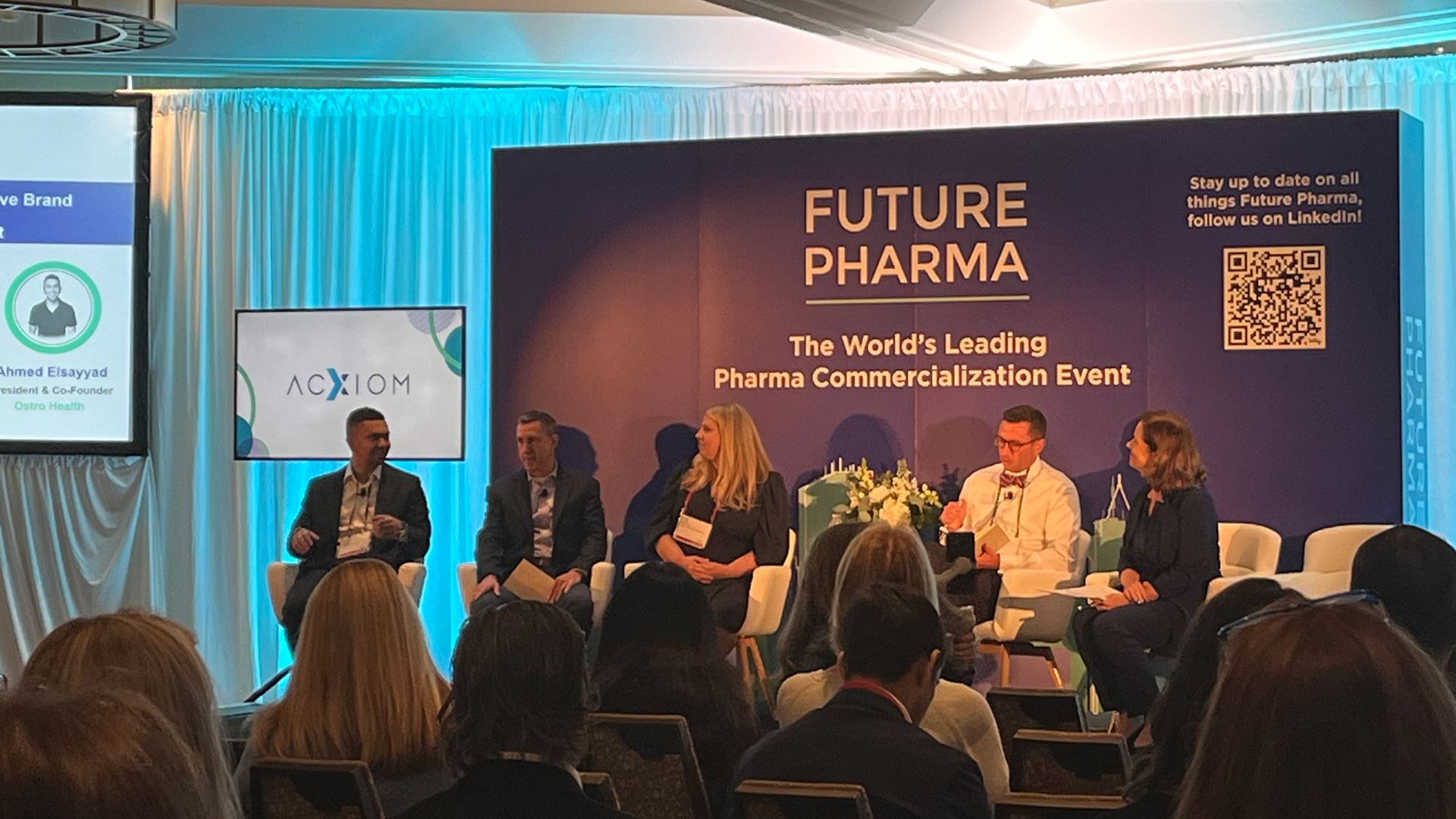
All event photographs courtesy of Jonah Comstock
Kovach says the role he sees for generative AI is to make suggestions to speed up human content generation, supported on the front end by traditional AI.
“How do we translate data into insights, and then insights into what we call a recipe? Based on that customer, which combination of content do they receive? And once we have that, how do we measure the performance of that content? How well did that promotional message perform?” he said. “So, we’ve got to think about using traditional AI, not generative AI, traditional AI, to gather that information and to make the correct recipes. Then, once you understand the performance of content, the next step is to think about generative AI.”
“I do think about the whole spectrum of innovation and, of course, it takes a village,” she said. “We think about vendor relationships, strategic partnerships, corporate venture capital, seed funding, and incubation as well. There's a wide variety of levers you can pull, and it really depends on what sort of impact you want to have. But our approach is a very multifaceted one.”
But how does big pharma select its innovation partners? On the same panel, Bristol Myers Squibb's head of digital and IT, Jalpa Dave, says they’re always making sure that new technology is in service of larger business goals.
“If we're specifically talking about bringing external solutions in-house, the important thing to remember is that everything needs to be strategy-driven,” she said. “The solution is a how. What's the why? What's the North Star vision you have for solving a problem? And the problem should be pretty ambitious. Then the ‘how’ can be a combination of external or internal innovation. But we always want to start with that 'why?' What is that vision?”
So that vendors can be helpful by proving they really understand the problem, the pain points, and the customer journey as well as companies do, she said.
“Help us see around corners,” Blanchette said. “Help us leverage your expertise as thought leaders in the industry. That's a differentiator for us. We have thousands of vendors that contact us on a daily basis. We have tens of thousands of suppliers in our cold chain. So, just a regular cold call or discussion or marketing outreach is not going to resonate with my particular group.”
“Right now, our targets, our consumers and our doctors are scattered all over the world, all over the web, and they are loyal to a couple of places, but they may go to multiple,” Heath Morlok, the associate director of integrated customer engagement in oncology at Merck, said. “And so we really have a hard time being everywhere at once. So, the solutions that really help us simplify things, help us be present in those multiple places. Where I think AI as a tool may help is to get us in just more quickly, condensing some of that information, some of that data, and being present.”
When it comes to patient services, AI is being used already in lots of ways, Louis Savant, director of patient access transformation strategies at Teva, said. It’s a speed play, but speed really matters.
“The advantage of AI is that it just helps you do things that you used to be able to do much faster. And in the patient services world, our activities, we call it south of the script. The script has already been generated, and now we're trying to look further. And every day that goes by that the patient doesn't get the medicine filled, the likelihood that it gets filled gets lower and lower. So, getting patients through the benefit verification process, the prior authorisation process, and everything, getting the script filled faster is better for patient care, and now it's a better business. It's the speed that's really important.”
As the dust settles from this year’s Future Pharma event, it's clear that AI isn't just another buzzword in the pharmaceutical industry. From ChatGPT crafting brand narratives to AI potentially levelling the playing field between pharma giants and small operation biotechs, the implications are far-reaching. Yet, as Merck's Marty Kovach cautions, the industry must temper its enthusiasm with pragmatism. The path forward lies in strategic implementation: using traditional AI to gather insights and craft "recipes" for customer engagement, leveraging AI to accelerate human-driven content, and partnering with vendors who truly understand pharma's unique challenges.

Jonah Comstock is a veteran health tech and digital health reporter. In addition to covering the industry for nearly a decade through articles and podcasts, he is also an oft-seen face at digital health events and on digital health Twitter.
Supercharge your pharma insights: Sign up to pharmaphorum's newsletter for daily updates, weekly roundups, and in-depth analysis across all industry sectors.


True content velocity requires balancing three key elements: creation, review, and distribution. Achieving this balance involves leveraging human expertise to build purpose-driven platforms and evolving workflows that cater to the unique demands of the pharmaceutical industry.
Here, Angela Tenuta, president, full-service agencies, EVERSANA INTOUCH, explores how pharmaceutical companies can master content velocity to deliver brand content with unparalleled speed, precision, and reach.
Would you be satisfied with a system that excels in creation, but falters in review or distribution? To truly optimise content velocity, all three components must function seamlessly, ensuring that content is created, reviewed, and distributed efficiently.
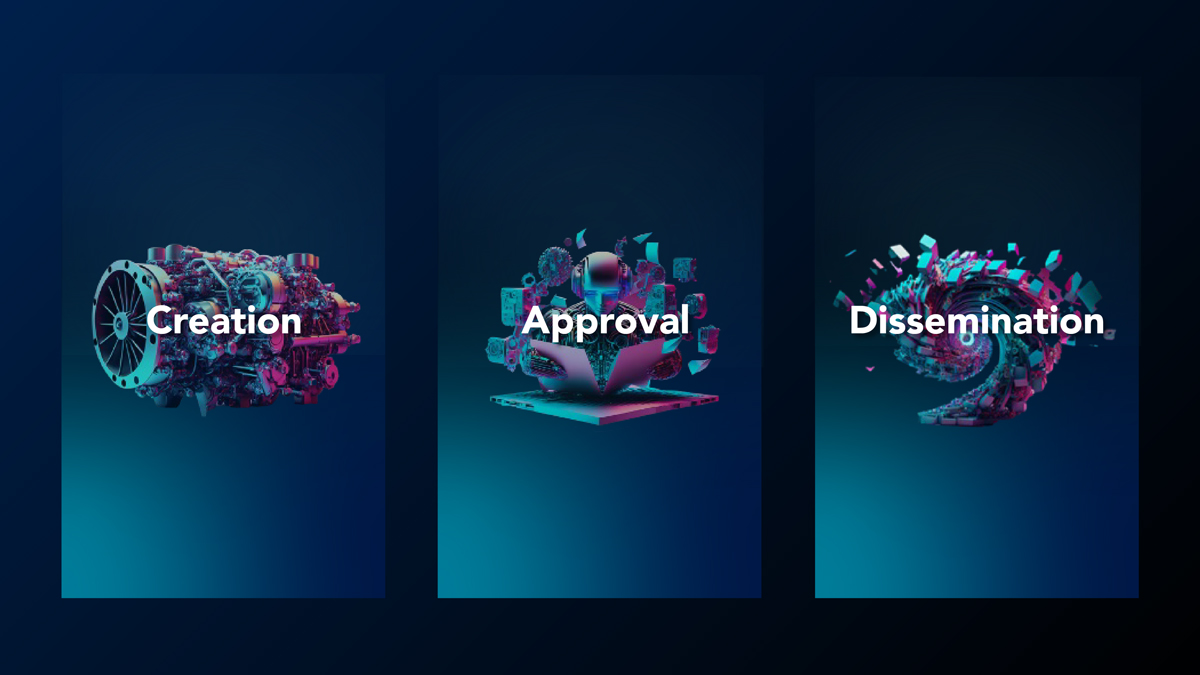
Creating content is fundamental. Everyone is doing it. But, in the pharmaceutical industry, it’s not just about producing content; it’s about making sure it’s personalised, relevant, and timely. Personalised content shows an understanding of your audience’s needs, relevant content addresses what they care about, and timely content ensures it’s delivered when it will have the most impact.
At EVERSANA INTOUCH, we talk about “pharmatising AI” – adapting advanced technology to meet the compliance standards of the life sciences sector. The benefits of generative AI (GenAI) are clear, but in this highly regulated field it’s not as simple as using a generic tool. Our industry requires compliant platforms tailored to brand guidelines, enabling scalable and personalised content creation.
A modular design approach is crucial for achieving content velocity and personalisation. By enabling low-code authoring, this approach streamlines creation, making it more cost-effective and scalable. When these content modules are paired with data, brands can deliver a tailored experience to each audience segment, enhancing both relevance and engagement.

Content review in pharma – often referred to as CMLR or med-legal or promotional review – is a critical process. It ensures content is accurate, appropriate, and compliant before it reaches the public, safeguarding patient safety, healthcare provider integrity, and brand reputation.
However, content review can be challenging. Multiple stakeholders need to review and approve content quickly and accurately, leading to potential bottlenecks. Collaboration and clarity are essential. Stakeholders must trust the process, understand their roles, and navigate the complexity with minimal confusion.
AI-powered solutions can streamline this process significantly. Automating up to 90% of the claims creation and management process using pre-approved sources reduces the need for manual input. This speeds up the review process and enhances accuracy by eliminating subjective bias. GenAI can further enhance efficiency by creating annotated references, linking them across materials, and generating live documents for real-time review.

Effective content distribution is the final piece of the content velocity puzzle. Even the most efficiently created and reviewed content loses value if it’s not distributed effectively. The challenge is delivering the right content to the right audience at the right time, across multiple channels, while maintaining compliance and relevance.
Purpose-built, AI-driven solutions can transform the distribution process. By automating workflows and leveraging data analytics, these tools ensure content reaches its intended audience quickly and accurately. This maximises reach and enhances engagement by delivering content that resonates with individual preferences.

To maintain a competitive edge in the pharmaceutical industry, transforming the content supply chain is essential. This requires a comprehensive approach that addresses content creation, review, and distribution – all while ensuring relevance and compliance. This transformation begins within the organisation, but is often supported by partners with proven expertise in evolving these critical processes.
Pharmaceutical companies must navigate regulatory challenges, personalise content, adapt to digital trends, and manage operational complexities to maintain content velocity. Whether developing in-house capabilities or partnering with external experts, the journey toward content velocity demands a commitment to process change, behaviour adaptation, and ongoing training.
As the pharmaceutical industry continues to evolve, so too must its approach to content velocity. By embracing AI-driven solutions, fostering collaboration, and continually refining workflows, brands can achieve a new standard in content delivery. This not only ensures compliance and efficiency, but also enhances relevance and personalisation, driving greater impact in the marketplace.
In today’s fast-paced environment, content velocity is not just a goal; it’s a necessity. By mastering the pillars of creation, review, and distribution, brands can deliver more meaningful content to their audiences faster than ever, setting a new benchmark for success in the industry.

Angela Tenuta, president, agency, EVERSANA INTOUCH
Angela Tenuta, president, agency, EVERSANA INTOUCH, is responsible for EVERSANA INTOUCH’s US-based business portfolios and best-in-class client service department. She has a track record of building integrated teams, pushing for novel approaches, and stopping at nothing to deliver great work. With over 20 years of marketing experience in the healthcare vertical, she has led our industry and our clients through many firsts. She has also opened four of EVERSANA INTOUCH’s six US locations. She has been recognised by our industry as a Healthcare Businesswomen’s Association Luminary, a PM360 Elite 100, Elite Mentor and Trailblazer. She keeps us on our toes while relying on her ballerina background to balance challenges and lead with grace.
Supercharge your pharma insights: Sign up to pharmaphorum's newsletter for daily updates, weekly roundups, and in-depth analysis across all industry sectors.

Especially at early stages, responsibility for communications often falls to internal teams with expertise in business development or marketing, rather than media relations. This can result in ad hoc campaigns to engage with media around a product launch or milestone – efforts that usually land with a thud.
Most companies’ internal teams can put together the pieces of media relations – for example, drafting a functional press release or phoning a reporter. But developing and executing the right communication strategy makes the difference between going through the motions and generating results that move the needle, whether the goal is supporting sales, generating inquiries, or building a long-term brand.
To get started, here are five key ideas to prioritise as you assemble a media communications strategy that will help you achieve your goals.
Your first challenge is to recognise your public perception. Are you unknown, understood, or misunderstood? Perhaps you’ve previously run communications campaigns or cycled through the trade show circuit. Maybe you have a well-known champion or key investor that has been singing your praises. On the other hand, maybe a competitor has framed you in a negative light.
Imagine walking into a party: the way your reputation precedes you will determine the tenor of your conversations. Knowing where you stand helps you determine whether you need to be starting conversations or continuing them.
From there, it becomes possible to think about goals. Do you need to raise your organisation’s CEO profile, or build brand awareness around a suite of services? If nobody knows your name, you may want to make a quick splash to make sure you’re remembered before you tell important news.
Your most important assets are your people, and they are likely to have expertise and unique perspectives that will interest the media – for the same reasons those experts are needed on your team. A good interview helps build bridges to reporters, leading to follow-up stories or podcast invitations. It also means the reporter or editor will keep the person in mind as a source for commentary on related topics and be more receptive to future news as well.
Look for the team players who have the right combination of subject matter expertise, perspective, and personality – which usually means friendly, humble, and enthusiastic. The best spokespeople are able to bring more than just talking points or memorised statistics to an interview; they can tell a story by explaining industry relevance, or the history or future of a space. They also have the flexibility to go off-topic.
Not everyone will be interested in speaking to the media regularly. We have had many clients with a rock star CEO who blows away conference audiences, but doesn’t see the value in making time for reporters. Or a bright, young, magnetic talent who gets nervous at the idea of saying the “wrong thing” on record. Or even someone who is uncomfortable being interviewed in a non-native language. A level of people management is required to coax these voices into the spotlight.
Similarly, nor will everyone have the right communication skills and temperament to interact with reporters. Sometimes, a really smart employee comes across off-putting because they approach an interview as though it is a waste of time, or like they are doing the journalist a favour. Some people spend so much time in a lab or interacting with customers that they find it difficult to move outside the world of their insular jargon.
To strengthen the value delivered through media interviews, spokespeople need to be “on brand”, speaking in line with the rest of the business. Over the years, I’ve seen many company executives answer media questions in contradiction to their peers.
Thankfully, many of these issues are addressable through media training. For the nervous or disinterested group, it’s useful to understand and then address their specific concerns. The best interviews feel like friendly conversations, rather than academic lectures. Sometimes, just helping someone lower their guard is the best way to build confidence. Helping someone think through the structure of an interview – with an introduction, question and answer period, and conclusions, rather than a script they need to memorise – can lead to more natural and useful conversation flows.
The backbone of a communications strategy is a well-thought-out news flow, which takes some planning in order to effectively tell your long-term, big-picture story.
First, if you have not already introduced yourself to media, consider a kick-off de-stealthing announcement. This gives you an opportunity to make a clear starting statement about what you are and introduce leadership and key stakeholders.
Next, assess any upcoming milestones on the horizon. Even if you start slowly, it is important to develop a consistent drumbeat of news, avoiding stop-and-start whenever possible. In this context, our clients often ask us – what makes news worthy of a press release? The first big factor is whether you can communicate the significance of the story externally. An example: your 1,000th sale might be cause for a banner in the break room. Framing it as the first among your competitors to reach a particular benchmark might be a signal worth amplifying.
The other factor is timing. How long is it between your outreaches to media contacts? Conversely, would promoting one piece of news step on efforts to promote a bigger announcement?
If news flow is the backbone, media relations is the connective tissue that fills in the gaps of your communication strategy. In fact, it can also be our blood flow – it can be that impactful. Here is where you can opinion lead, educate, persuade, and inform. If journalists don’t have opportunities to speak to you between announcements, it is easy for them to forget your people and your story.
Prepare by identifying topics that your experts can speak to, with a clear understanding of how entering such conversations will support your message. Media relations allow you to do things you can’t really do with news, such as introducing your C-suite, educating the market, and being an opinion lead. The downside is that you can only do this with one outlet at a time, so you still need to balance this with news that can get attention across multiple publications.
There are two types of media relations: proactive and reactive. The former represents an opportunity to drive conversations in your field, centred on perspectives you are uniquely positioned to offer. These can also build your credibility with reporters as a source for reactive opportunities, which is perhaps even more crucial. If competitors are included in a conversation and you’re not, that has an impact on your share of voice. You could be missing out on accessing a captive audience.
It’s important to remember that even under the best of circumstances, the media is never going to act as a mouthpiece for your marketing material. Reporters and editors craft stories that are of interest to their audiences, and it is up to you to intrigue them with angles that both meet your communication needs and theirs. This takes a degree of creativity.
Inspiration can come from a variety of places. Read the publications you hope to be covered in, and their reporting can give you a sense of which topics are hot. Tap into broader industry conversations that are taking place at conferences – especially your own presentations and roundtables. Solicit feedback from sales and marketing teams to understand what is resonating with customers. Sometimes, it just takes repackaging your existing messages in the context of language and themes that audiences are looking for at that moment.
This is an opportunity for thought leadership. Your work addresses (or has overcome) specific industry challenges and sharing even broad solutions can demonstrate your company’s expertise to your field.
Still, there needs to be a balance between creativity and strategy. It might be easier to get involved in hot conversations, but that has to serve your message and speak to your target audience. If your customers are ahead of reporters on a topic, it might take a persistent campaign to educate the media on what the next hot story will be.
Rome wasn’t built in a day; a strong media strategy is built around consistency, much as a first cold call rarely results in a sale. Reporters are deluged by media campaigns and press releases every day, and it can be hard to get someone who doesn’t know you to even open your email. Prioritise building relationships with reporters and editors, starting with a good first impression.
Face-to-face interactions are great when possible, for example, at conferences. Helping a reporter out with a source when they need one – even if it isn’t strictly necessary for your strategy – can also build goodwill (but don’t expect a quid pro quo). Reach out when you read a good story of theirs, even if there’s no angle for you to offer commentary.
Your relationships with reporters will not be equal. Publications are the gatekeepers, and reporters have their own deadlines, editors, and audiences to serve. It can be useful to think of them as clients in that you aim to offer them good services, for example, providing interesting stories, offering reliable sources, or being flexible regarding time zone differences. Try not to waste their time – do your homework to ensure that the topics you pitch are right for the reporters.
Other relationships are important for your communications strategy, too. Leverage connections with investors, partners, and clients who might already have a strong connection with a reporter. Build bridges with others in your field – even competitors, where appropriate – to encourage broader media conversations together that you can take part in.
A communication strategy that lives only in a document isn’t a strategy. Too often, I’ve seen companies get so lost in planning that it drags on well past the intended strategy kick-off.
There is a risk in thinking about your plan too rigidly. Many variables can throw a timeline off course, whether it’s a partner taking too long to review a joint press release or a key spokesperson going on holiday. Build in some flexibility and contingencies where possible, and stay open to larger adjustments when needed.
Along those lines, don’t lock yourself into a strategy that doesn’t work. Develop realistic benchmarks before launching, and be prepared to pivot if it becomes clear your approach isn’t working.

Michelle Boxall, CEO, IB Communications
Michelle Boxall is CEO and founder of IB Communications, a leading international communications agency specialising in healthcare & life sciences.
She holds a Bachelor of Arts PR degree and 28 years communications experience working primarily in the biotech & biopharma sectors, including immunotherapy, regenerative medicine, ATMPs & CGT.
Supercharge your pharma insights: Sign up to pharmaphorum's newsletter for daily updates, weekly roundups, and in-depth analysis across all industry sectors.



Lind’s experiment – often hailed as the world’s first clinical trial – not only established the principle of using control groups, but also demonstrated the power of a well-told story. His clear and concise communication of the findings resonated with sailors, who gradually adopted the practice of bringing lemons and other sources of vitamin C on long voyages.
Fast forward to today, where the sheer volume and complexity of scientific research dwarf Lind’s simple experiment. We live in an era of information overload, where groundbreaking discoveries in life sciences are announced almost daily. Although this represents an impressive measure of human ingenuity, it also presents a communication challenge. How do we ensure that this vital knowledge is not only understood, but also embraced by healthcare professionals (HCPs), payers, regulators, patients, and other crucial stakeholders?
Science communication is the bridge between cutting-edge research and those it impacts. It involves not just explaining the “what” and “how” of science, but also the “why” – its relevance and potential to change lives. This is where the art of storytelling is intertwined with the rigour of scientific data.

In medical communication, it's crucial to tell stories that make complex scientific data understandable to different audiences. But the true magic happens when the balance is struck between emotional resonance and scientific rigour. Meticulous analysis of clinical trial data – from patient demographics and outcomes to statistical significance – uncovers the key insights that form the narrative’s backbone. It is about identifying the “So what?” within the data, connecting cold statistics and transforming numbers into compelling insights with real-world implications.
Once this foundation of understanding is established, the art of storytelling takes over. We weave the data into narratives that feature relatable characters, clear arcs, and resolutions that inspire hope and action. Whether it is a patient sharing their journey, a researcher communicating trial findings or a physician explaining a new treatment, these stories forge an emotional connection that facts alone cannot achieve.
When done right, medical storytelling can:

However, navigating this ever-changing landscape requires more than intuition or guesswork. It demands rapid access to actionable insights that can inform and shape communication strategies in real time. Without this agility, there is a risk of missing critical developments that could alter the narrative, leaving a vacuum for others to fill with their own interpretations.
Data insights are the cornerstone of a responsive and effective communication strategy. These insights are not just numbers; they are the building blocks for creating meaningful, targeted, and impactful medical stories that drive real-world change.
Harnessing machine learning and automated algorithms across multiple data sources provides a holistic view of the medical landscape, enabling the identification of emerging trends, competitive activities, and unmet needs.
By leveraging analytical capabilities, we can:
Progress demands iteration. The cycle of tracking, analysing, refining, and improving enables us to stay competitive, adapt to changing circumstances and consistently deliver better results. In this way, data acts as a catalyst for effective storytelling in medical communications, allowing us to proactively shape narratives, anticipate potential challenges, and respond effectively to new information. It empowers us to build narratives that are not only grounded in evidence, but also responsive to the ever-changing needs of our audiences. This ensures that our messages continue to remain relevant and cut through in a way that drives meaningful change in a constantly evolving landscape.

By combining scientific rigour with the art of storytelling and leveraging data insights as a strategic compass, we can create medical communications where complex science is not just understood, but embraced, ultimately driving positive change in healthcare.
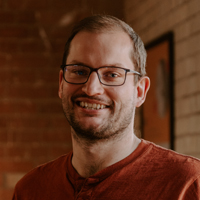
Adam Goodband, science communication director, Enzyme Communications
Adam Goodband is a co-founder of Enzyme Communications, now part of the Bioscript Group. He has focused his career on blending scientific understanding with strategic and creative thinking – a mix of skills offered under the umbrella of ‘Science Communication’. Goodband has had the good fortune to work in most markets, but primarily European and Asia-Pacific. He has supported education, storytelling, and product launches across many therapy areas.
Supercharge your pharma insights: Sign up to pharmaphorum's newsletter for daily updates, weekly roundups, and in-depth analysis across all industry sectors.



Sage Therapeutics has launched another round of layoffs as it deals with the fallout of abandoning a key pipeline drug for Alzheimer's and Parkinson's disease.


Identifying high-volume prescribers and engaging with key opinion leaders (KOLs) in a target therapeutic area can be a challenge.

In this issue, we unpack Ozempic’s rise to superstar status and the risks associated with its off-label use.
In the age of AI, large data sets – like the treasure trove of customer data most biopharma companies are sitting on – are an invaluable asset.

At LSX in Boston last month, editor-in-chief Jonah Comstock caught up with Dr Tadaaki Taniguchi, chief medical officer at Astellas Pharmaceuticals to talk a bit about the company and some r

The launch environment for pharmaceutical industry products is evolving at pace with new scientific discoveries and shifting engagement patterns, creating challenges and opportunities.

BIO-Europe™ celebrates 30 years of facilitating partnerships this Fall. In 1994, BIO-Europe launched with the mission to drive biotech innovation and

Industry’s Destination to Discover & Develop Best-In-Class Drugs for Immuno-Inflammatory Skin Disease